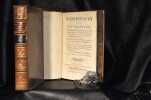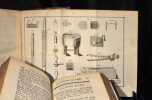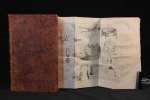12 books for « ingen housz j »Edit
-
Topics
Biology (3)
Botany (3)
Discovery (1)
Ecology (1)
Electricity (1)
Explosive (1)
Physics (2)
Sciences (1)
Tea (1)
-
Countries
Denmark (4)
France (7)
Switzerland (1)
-
Syndicate
CNE (1)
ILAB (5)
SLAM (1)
Nouvelles expériences et observations sur divers objets de physique -- EDITION ORIGINALE -- REUNION PAR INGEN-HOUSZ DE DIVERS MEMOIRES QU'IL AVAIT PUBLIE DANS DIVERSES REVUES -- BON EXEMPLAIRE
P., Barrois, 1785, un volume in 8 relié en demi-basane, dos orné de fers et filets dorés, (reliure de l'époque), (petit accroc à la coiffe, infime piqure de vers à un mors), 37pp., (1pp.), 498pp., 1 tableau dépliant, 3 planches dépliantes numérotées 1 à 4, les planches 3 & 4 étant réunies sur une même page
---- EDITION ORIGINALE ---- BON EXEMPLAIRE ---- Ex-Libris de la bibliothèque du Chateau des Ormes ---- Réunion par Ingen-Housz lui-même de divers mémoires qu'il avait publié dans diverses revues de l'époque ---- "Ingen-Housz' earliest scientific interest was in the field of physics, especially electricity. He was the first to use disks instead of revolving cylinders or globes in electrostatic generators. He explained the phenomena of Volta's electrophore by means of Franklin's theory of positive and negative electricity, a crucial demonstration of the correctness of Franklin's view. He also entered the controversy on blunt lightning rods (advocated by Wilson) versus pointed ones (advocated by Franklin). He experimentally refuted the statement that plant growth is promoted by electricity. In the field of magnetism, Ingen-Housz experimented with artificial magnets, made according to the ideas of Gowin Knight, and revised methods of dampening the vibrations of magnetic needles. He also discovered the paramagnetism of platinum...". (DSB VII pp. 11/16) ---- Précis du système de M. Franklin sur l'électricité - Théorie des phénomènes de l'électrophore, accommodée aux principes du système franklinien - Exposition de plusieurs lois qui paraissent s'observer constamment dans les divers mouvements du fluide électrique et dont la connaissance est nécessaire pour l'intelligence des phénomènes de l'électrophore - Description d'une nouvelle machine électrique, peu sujette à être endommagée, et très utile pour se procurer en tout temps de la lumière - Description d'une petite machine électrique de poche pour tirer un pistolet à air inflammable - Manière de produire une lumière des plus éblouissantes par l'air déphlogistiqué - Essai sur une nouvelle manière de produire un vide - Lettre à M. Van-Breda au sujet d'une manière très facile et peu dispendieuse, de se procurer, en tout temps, un air inflammable et explosif et sur la force extraordinaire d'un nouvel air explosif - Sur la nature de l'air déphlogistiqué - Du magnétisme et des aimans artificiel - etc**2757/L2
Expériences sur les végétaux spécialement sur la propriété qu'ils possèdent à un haut degré, soit d'améliorer l'air quand ils sont au soleil, soit de le corrompre la nuit ou lorsqu'ils sont à l'ombre auxquelles on a joint une méthode nouvelle de juger du degré de salubrité de l'atmosphère - Traduit de l'anglais PAR L'AUTEUR -- Deuxième édition REVUE ET AUGMENTEE -- 2 VOLUMES (COMPLETE SET)
P., Barrois, 1787/1789, 2 volumes in 8 reliés en demi-basane à coins, dos ornés de filets dorés (reliures de l'époque), (petit accroc à une coiffe, quelques rousseurs), T.1 : 112pp., 384pp., (1), 1 PLANCHE DÉPLIANTE, T.2 : (2), 56pp., 509pp., (1pp.), (1)
---- Deuxième édition française REVUE et AUGMENTEE ---- "Inghen-Housz'further studies on plant assimilation and respiration" ---- "Ingen-Housz showed that the green parts of plants, when exposed to light, fix the free carbon dioxide of the atmosphere, but that in darkness plants have no such power. Thus he proved that animal life is dependent ultimately on plant life, a discovery of fundamental importance in the economy of the world of living things". (Garrison N° 103 & 145.52 1st english ed.) ---- Norman N° 1142 : "The second volume contains the results of Ingen-Housz's further studies on plant assimilitation and respiration, which led him to believe that plants and animals are mutually supportive, the animals consuming oxygen and producting carbon dioxide, and the plants doing exactly the reverse. The volume also contains Ingen-Housz's rebuttals to the criticisms of Priestley and Senebier, who disputed his claim to the discovery of photosynthesis and plant respiration" ---- Dibner N° 29 & Horblit N° 55 1st english ed**2758/A2
INGEN-HOUSZ (INGENHOUSZ), JOHN. - DISCOVERY OF PHOTOSYNTHESIS - THE CLASSIC OF ECOLOGY.
Reference : 53319
(1780)
Expériences sur les Végétaux, spécialement sur la Propriété qu'ils possèdent à un haut degré, soit d'améliorer l'Air quand ils sont au foleil, soit de corrompre la nuit. ou lorsqu'ils sont à l'ombre" auxquelles on a joint unde Méthode nouvelle...
Paris, Théophile Barrois, 1780. 8vo. Fine cont. full mottled calf, richly gilt spine and gilt titlelabel in red leather. Edges gilt. LXVIII,333,(3) pp. and 1 folded engraved plate (showing his experimental apparatus). Light browning to margins of title-page, otherwise clean and with broad margins. A fine copy.
First French edition of perhaps the most important work in plant physiology. It is in this work that Ingen-Housz for the first time expounds the ideas and experiments that lead to his discovery of Photosynthesis in plant life, and as such it is of fundamental importance in the economy of living things. ""His Experiments upon vegetables was published in the autumn of 1779 and was at once recognized as a very important advance. In brief he showed, that oxygen evolution by plant is absolutely dependent on light and that it only occurs from those parts which are green...The proof that light and green tissues are both essential for oxygen production finally cleared up the apparent contradictions and variable results of earlier experiments. Priestly was ""much pleased"" with Ingen-Housz's experiments and pointed immediately to the salient facts that he had established."" (A.G. Morton: History of Botanical Science. p. 332.). Dibner: Heralds of Science No. 29. - Garrison & Morton No. 103. - Horblit No. 55. (All the English edition of 1779).
Expériences sur les végétaux spécialement sur la propriété qu'ils possèdent à un haut degré, soit d'améliorer l'air quand ils sont au soleil, soit de le corrompre la nuit, ou lorsqu'ils sont à l'ombre ; auxquelles on a joint une méthode nouvelle de juger du degré de salubrité de l'atmosphère. Traduit de l'anglais PAR L'AUTEUR -- BEL EXEMPLAIRE
P., Barrois, 1780, un volume in 8 relié en demi-basane, dos orné de fers et filets dorés (reliure de l'époque), 68pp., 333pp., (1pp.), (1), 1 PLANCHE DEPLIANTE
---- PREMIERE EDITION FRANCAISE TRADUITE PAR INGEN-HOUSZ lui-même ---- BEL EXEMPLAIRE ---- "A DISCOVERY OF FUNDAMENTAL IMPORTANCE IN THE ECONOMY OF THE WORLD OF LIVING THINGS". (Garrison) ---- "Ingen-Housz showed that the green parts of plants, when exposed to light, fix the free carbon dioxide of the atmosphere, but that in darkness plants have no such power. Thus he proved that animal life is dependent ultimately on plant life, a discovery of fundamental importance in the economy of the world of living things". (Garrison N° 103 & 145.52 1st english ed.) ---- Dibner N° 29 & Horblit N° 55 1st english ed**7931/A1
Expériences sur les végétaux
Paris, Théophile Barrois le jeune [Didot le jeune], 1780, in-8, de LXVIII, 333, (3) pages et 1 planche, pleine-basane moucheté de l'époque, dos à 5 nerfs orné, La découverte de la photosynthèse et exemplaire de Paul Broca Première édition française traduite par l'auteur, après l'édition originale anglaise publiée en 1779. Dans cette ouvrage Ingen-Housz expose les résultats de ses recherches sur l'assimilation et la respiration des plantes, il soutien que comme les animaux cette respiration a lieu jour et nuit, mais qu'à la différence de ces derniers, les plantes consument du dioxyde de carbone et produisent de l'oxygène. Il soutien en outre que seulement la partie verte peut améliorer l'air grâce aux rayons du soleil, mais que chaque partie de la plante "green as well as nongreen, flowers and fruits as well as roots" (DSB VII, pag.12) participe au processus. Après la préface une planche repliée représente les instruments utilisés par l'auteur pour ses expériences sur la respiration des végétaux. Sur le premier contre-plat l'ex-libris imprimé de Paul Broca. Ce dernier, médecin, anatomiste et anthropologue français, est très connu pour ses études et ses découvertes sur l'aphasie. Malgré quelques rousseurs en marges, bon exemplaire d'une belle provenance. Pour l'édition originale anglaise voir Norman 1141, Dibner 29 et Horblit 55 ; DSB, VII, p. 11-16. Couverture rigide
Bon de LXVIII, 333, (3) pages et
On some new Methods of suspending Magnetical Needles. Read June 17, 1779.
(London, J. Nichols, 1779). 4to. Extract from ""Philosophical Transactions, of the Royal Society of London."" Vol. 69, Year 1779 - Part II. Pp. 537-546 and 1 folded engraved plate.
First printing. ""In the field of magnetism, Ingen-Housz experimented with artificial magnets, made according to the ideas of Gowin Knight, and devised methods of dampening the vibrations of magnetic needles. He also discovered the paramagnetism of platinum.""(DSB).
NOUVELLES EXPERIENCES ET OBSERVATIONS SUR DIVERS OBJETS DE PHYSIQUE, par Jean Ingen-Rousz, Conseiller aulique et médecin du corps de Sa Majesté l'Empereur et Roi, Membree de la société royale de Londres, de la Société Philosophique Américaine de Philadelphie.
Paris chez Barrois 1785-89 -in-8 bradel 2 volumes, reliure bradel marron in-octavo (bradel binding in-8) (20,8 x 13,3 cm), dos long (spine without raised band), titre et tomaison frappés or (gilt title and volume numbering), pièce de titre et de tomaison sur fond tête de nègre avec filet et roulette "or" de part et d'autre, filet "or" en place des nerfs, roulette "or" en tête et en pied, dos et plats recouverts de papier peigné marron (cover with painting paper), toutes tranches lisses jaspées bleues, orné de 5 planches hors-texte dépliantes gravées sur bois en noir (dont une en couleurs) et 1 tableau dépliant hors-texte gravé sur bois en noir, (xxxvii + 498) + (xx + 574) pages, 1785-1789 Paris, chez Barrois Editeur,
Précis du système de M. Franklin sur l'électricité - Théorie des phénomènes de l'électrophore, accommodée aux principes du système franklinien - Exposition de plusieurs lois qui paraissent s'observer constamment dans les divers mouvements du fluide électrique et dont la connaissance est nécessaire pour l'intelligence des phénomènes de l'électrophore - Description d'une nouvelle machine électrique, peu sujette à être endommagée, et très utile pour se procurer en tout temps de la lumière - Description d'une petite machine électrique de poche pour tirer un pistolet à air inflammable - Manière de produire une lumière des plus éblouissantes par l'air déphlogistiqué - Essai sur une nouvelle manière de produire un vide - Lettre à M. Van-Breda au sujet d'une manière très facile et peu dispendieuse, de se procurer, en tout temps, un air inflammable et explosif et sur la force extraordinaire d'un nouvel air explosif - Sur la nature de l'air déphlogistiqué - Du magnétisme et des aimans artificiel - etc......Beaux Exemplaires.............TRES RARES...........en bon état (good condition). bon état
Expériences sur les végétaux spécialement sur la Propriété qu'ils possèdent à un haut degré, soit d'améliorer l'Air quand ils sont au soleil, soit de le corrompre la nuit ou lorsqu'ils sont à l'ombre
Paris, Chez Théophile Barrois le jeune, Libraire, quai des Augustins, n°18, Seconde édition. Deux volumes in-8, plein-veau, dos à cinq nerfs ornés de fleurons, pièce de titre en maroquin rouge, pièce de tomaison en maroquin vert.
Jan Ingenhousz est un médecin et botaniste britannique d'origine néerlandaise, né le 8 décembre 1730 et mort le 7 septembre 1799. Dans Expériences sur les végétaux, et à la suite des travaux de Priestley sur l'oxygène, il découvre le rôle de la lumière dans la photosynthèse.Belle édition de cet ouvrage botanique important.
Vermischte Schriften physisch=medizinischen Inhalts. Uebersetzt und herausgegeben von Niklas Karl Molitor, nebst einigen Bemerkungen über den Einfluss der Pflanzen auf das Thierreich. Mit Kupfertafeln.
Wien, Johann Paul Krauss, 1782. Cont. boards. Titlelabel with gilt lettering on back. Some repairs to back and lightly rubbed. Stamp on title. LXVI,(2),415,(1) pp. and 4 large folded engraved plates. Broad margins. Internally fine and clean.
Scarce first German edition of 17 tracts and memoirs by the discoverer of Photosynthesis. The tracts relates to plant-physiology, chemistry, metallurgy, medicine etc.
Account of a new Kind of inflammable Air or Gass, which can be made in a Moment without Apparatus, and is fit for Explosion as other inflammable Gasses in use for that Purpose" together with a new Theory of Gun-Powder. Read March 25, 1779.
(London, J. Nichols, 1779). 4to. Extract from ""Philosophical Transactions, of the Royal Society of London."" Vol. 69, Year 1779 - Part II. Pp. 376-418 and 1 folded engraved plate, showing apparatus (air pistols etc.).
First printing of Ingenhouz's memoir in which he shows a new way to make inflammable air. - Ingenhouz is most widely known for his discovery of photosynthesis which he published in the same year as the offered paper (1779).""An interesting paper written from the point of view of a phlogistonist and dealing with the forces of explosions of air or oxygen and ether vapour. Contains frequent references to Priestly and also to Lavoisier, Cavendish, Fontana.""(Duveen, p. 305).""In 1779, Jan Ingenhouz, also reported new ways of making inflammable airs. He had learnt the first method from John Cuthberson and Hendrik Aeneae on a visit to Amsterdam in 1777...When he returned to London, he tried to find simpler ways of generating the air so that it could be used as a substitute for inflammable air from metals in Volta's inflammable air pistol. He devised a way of volatising ether (Diethyl ether) for this purpose, but he thought that these to airs were the same.""(Leslie Tomary).
Expériences sur les végétaux, spécialement sur la propriété qu’ils possèdent à un haut degré, soit d’améliorer l’air quand ils sont au soleil, soit de le corrompre la nuit lorsqu’ils sont à l’ombre; auxquelles on a joint une méthode nouvelle de juger du degré de salubrité de l’atmosphère.
Paris, Didot le Jeune, 1780. In-8 de LXVIII, 333-[4] pages. Plein veau marbré, dos à nerfs orné, tranches rouges (rel. de l’époque, petit manque à la coiffe sup., petite érafflure au second plat, très rares rousseurs).
1 planche dépliante. Première édition française (traduite par l’auteur). Exemplaire provenant de la vente de la bibliothèque de Abraham Trembley et Charles Bonnet, dispersée les 5&6 octobre 1970 (lot 418). La découverte du rôle de la lumière dans la photosynthèse.
Expériences sur les végétaux spécialement sur la propriété qu'ils possèdent à un haut degré, soit d'améliorer l'air quand ils sont au soleil, soit de le corrompre la nuit, ou lorsqu'ils sont à l'ombre, auquelles on a joint Une méthode nouvelle de juger du degré de salubrité de l'atmosphère.
Paris chez P. Fr. Didot le jeune 1780. In-8 (20X12,5 cm), LXVIII-333 pages-3 pages n. chiffrées, une planche dépliante de 16 figures gravées. Basane époque, coiffe inférieure, coupes et coins usés; petit manque au plat supérieur. Sans la pièce de titre. Bon état intérieur. (XVI)- (300gr.)
Traduction de l'anglais par l'auteur lui-même de cet ouvrage capital traitant de la photosynthèse.
 Write to the booksellers
Write to the booksellers













